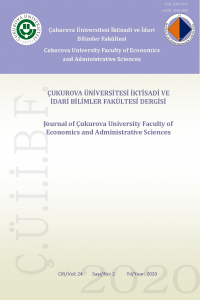Balassa-Samuelson Hipotezinin İçsel Aktarım Mekanizmasının Türkiye Ekonomisi İçin Test Edilmesi
Bu çalışmanın amacı, Türkiye ekonomisi ve EU-27 bölgesi arasında Balassa-Samuelson (B-S) (1964) hipotezinin içsel
aktarım mekanizmasını 2001:Q1-2014:Q1 dönemini kapsayan veri seti ile Gecikmesi Dağıtılmış Ardışık Bağımlı
Modeller Analizi (ARDL) sınır testi yaklaşımını kullanılarak sınamaktır. Sonuçlar, B-S hipotezinin içsel aktarım
mekanizmasını desteklemektedir. 2001 sonrasında, Türkiye ve EU-27 arasında, göreceli fiyat farklılığındaki artışın
göreceli verimlilik farklılığındaki artıştan kaynaklandığı sonucuna ulaşılmıştır.
Anahtar Kelimeler:
Balassa-Samuelson Hipotezi, içsel aktarım mekanizması, verimlilik, ARDL, eşbütünleşme
___
- Alberola, E. & Tyrväinen, T. (1998). Is There Scope for Inflation Differentials in EMU? An Empirical Evaluation of the Balassa-Samuelson Model in EMU Countries. Bank of Spain Working Paper, No. 9823.
- Asea, P. & Mendoza, E. (1994), The Balassa-Samuelson Model: A General Equilibrium Appraisal, Review of International Economics, 2 (3), 244-267.
- Balassa, B. (1964). Purchasing Power Parity Doctrin: A Reappraisal, The Jourmal of Political Economy, 72, 584-596.
- Bayram, T. (2007). Balassa Samuelson Model Revisited: Growth Productivity Effect & Capital Accumulation. International Research Journal Financial Economics, 9, 144-155.
- Bergstrand, J.H., (1991). Structural Determinants of Real Exchange Rates and National Price Levels: Some Empirical Evidence. American Economic Review, 81, 325– 334.
- Bhagwati, J. N. (1984). Why are services cheaper in the poor Countries. The Economic Journal, 94, 279-286.
- Coudert, V. (2004). Measuring the Balassa-Samuelson Effect for the Countries of Central and Eastern?, Banque DeFrance Bulletein, 122.
- Çeliku E. & Hoxholli, R. (2007). An Estimation of Balassa Samuleson Effect in Albania, Bank of Albania.
- DeGregorio, J. , Giovannini, A. ve Wolf, H. (1994). International Evidence on Tradables and Nontradables Inflation, European Economic Review, 38, 1225- 1224.
- Dimutru, I. & Jianu I. (2009). The Balassa Samuelson Effect in Romenia: The Role of Regulated Prices, European Journal of Operational Resaerch,194, 873-887.
- Égert, B. (2003). Nominal and Real Convergence in Estonia The Balassa-Samuelson (dis)connection. William Davidson Institute Working Papers, 556.
- Égert, B. , Halpern, L. & MacDonald R. (2006). Equilibrium Exchange Rates in Transition Economies: Taking Stock of the Issues. Journal of Economic Surveys, 20(2), 257-324.
- Enflasyon Görünümü Raporu II, (2006). Türkiye Cumhuriyeti Merkez Bankası
- Funda, J, Lukinic, G. & Ljubaj, I. (2007). Assessment of the Balassa-Samuelson Effect in Croartia, Financial Theory and Practice, 31, 4, 321-351.
- Halpern, L, ve Wyplosz, C. (2001). Economic Transformation and Real Exchange Rates in the 2000s: The Balassa-Samuelson Connection. Geneve: UN/ECE.
- Isard, P. (1995). Exchange Rate Economics, England: Cambridge University Press.
- Harrod, R. F. (1933). International Economics, Nisbet & Cambridge University Press.
- Juselius, K. & Ordóñez, J. (2009). Balassa-Samuelson and Wage, Price and Unemployment Dynamics in the Spanish Transition to EMU Membership, The Open Access, Open Assessment E Journal, 3, 1-30.
- Kakkar, V. (2003). The Relative Price of Nontraded Goods and Sectoral Total Factor Productivity: An Emprical Investigation. The Review of Economics and Statics, 85(2), 444-452.
- Kastimi, M. (2004). Inflation Divergence in the Euro Area: The Balassa Sameulson Effect. Applied Economic Letters, 11(5), 329-332.
- Kohler, M., 2000. The Balassa–Samuelson effect and monetary targets. In: Mahadeva, L., Sterne, G. (Eds.), Monetary Frameworks in a Global Context. Bank of England and Routledge, London, 354–390.
- Kravis,I., B. & Lipsey, R., E. (1982), Towards an Explanation of National Price Levels NBER Working Paper,1034, 1-49.
- Lojschova, A. (2003). Estimating the Impact of the Balassa-Samuelson Effect in Transition Economies. Vienna: Institute for Advanced Studies.
- Lommatzch, K. & Tober, S. (2004), What is behind the Real Appreaciation of the Accession Countries’ Currencies? An Investigation of the PPI-based Real Exchange Rate, Economic Systems, 28, 383-403.
- Lommatzch, K. & Tober, S. (2006). Euro-Area Inflation: Does the Balassa-Samuelson Effect Matter?, International Economics and Economic Policy. 3(2), 105-136.
- Masten, I. (2007). Inflation targeting in presence of Balassa-Samuelson-type productivity shocks. Available at SSRN 967650.
- Mihaljek, D. & Klau, M. (2008), Catching-up and Inflation in Transition Economies:The Balassa-Samuelson Effect Revisited, BIS Working Papers, 270.1-23.
- Ng, S., & Perron, P. (2001). Lag length selection and the construction of unit root tests with good size and power. Econometrica, 1519-1554.
- Obstfeld, M. & Rogoff K. (1996). Foundations of International Macroeconomics, Cambridge, MA: The MIT Press.
- Pesaran, M. H. , Shin, Y. ve Smith, R. J. (2001). Bound Testing Approaches to the Analysis of Long-Run Relationships. Journal of Applied Econometrics, 16, 289-326.
- Rogoff, R. (1992). Traded Goods Consumption Smoothing and the Random Walk Behavior of the Real Exchange Rate. NBER Working Papers Series, 4119, 1–34.
- Samuelson, P. A. (1964). Theoretical Notes on Trade Problems, Review of Economics and Statistics, 46, 2, 145-54.
- Tica, J. & Druzic, I. (2006). The Harrod-Balassa-Samuelson Effect: A Survey of Emprical Evidence, FEB Working Papers, 0607, 1-37.
- ISSN: 1300-3747
- Başlangıç: 1987
- Yayıncı: Çukurova Üniversitesi
Sayıdaki Diğer Makaleler
Avrupa Birliği İstihdam Politikaları
Avrupa Birliği ve Türkiye’de Kurumların İşgücü Piyasalarına Etkileri
Balassa-Samuelson Hipotezinin İçsel Aktarım Mekanizmasının Türkiye Ekonomisi İçin Test Edilmesi
Kargo Şirketi Seçimine Yönelik Kriterlerin Belirlenmesinde Türkiye Genelinde Bir Saha Araştırması
Doğrudan Yabancı Sermaye Yatırım İkliminin Oluşturulmasını Belirleyen Faktörler
Makro Ekonomik ve Politik İstikrarsızlığın Ekonomik Performans Üzerine Etkisi: Latin Amerika Örneği
Ülke Riski Bileşenlerinin Bankacılık ve Reel Sektör Üzerine Etkileri: Türkiye Örneği, 1993-2015
Recep KÖK, Ramazan EKİNCİ, A. Elif Ay YALÇINKAYA
Gelişmekte Olan Ülkelerde Yaygın Eğitimin Yoksulluğu Azaltma Üzerindeki Etkisi
